|
|
|
Sort Order |
|
|
|
Items / Page
|
|
|
|
|
|
|
| Srl | Item |
| 1 |
ID:
170361
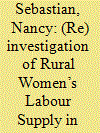

|
|
|
|
|
| Summary/Abstract |
This article examines the role of household poverty in shaping rural female labour supply using the unique panel dataset of India Human Development Survey. The results using Vella and Verbeek’s two-step panel estimation reveal the presence of a backward-sloping labour supply curve for rural women from below poverty line households, and an upward-sloping labour supply for rural women from above poverty line (APL) households. This implies the existence of ‘forced’ or ‘need-based’ participation among poor women and justifies why they work long hours in poorly paid hazardous jobs. The article also finds horizontal labour supply among agriculture wage workers and for Adivasi and Dalit rural women to some extent, reflecting limited job options, and surplus unskilled labour who are unable to demand higher wages for their labour supply. On the other hand, when categorised by occupation type, the downward-sloping labour supply for rural women from APL households indicates the dominance of the income effect over the substitution effect, and the socio-cultural factors that gain strength as income levels increase.
|
|
|
|
|
|
|
|
|
|
|
|
|
|
|
|
| 2 |
ID:
162546


|
|
|
|
|
| Summary/Abstract |
This paper examines the security relationship between the US and Europe, focusing on potential spillin effects of US military expenditures on European demand for military expenditures during the early twenty-first century. The goal is to test whether or not European states view US expenditures as a complement or as a substitute to their own military expenditures. Past work in this area has found mixed results concerning the effect of US military expenditures, but focus strictly on the spillins within a formal alliance, specifically NATO, and use a time series dominated by Cold War dynamics. This study differentiates itself by accounting for both US total military expenditures and its regional expenditures through incorporation of US military base and personnel deployments across Europe. Additionally, this paper uses government revenue in its estimation to mitigate potential endogeneity. Findings using Arellano–Bond dynamic panel analysis suggest that there is a strong probability of substitution among European states.
|
|
|
|
|
|
|
|
|
|
|
|
|
|
|
|
| 3 |
ID:
179117
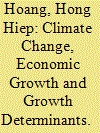

|
|
|
|
|
| Summary/Abstract |
Using the Feasible Generalized Least Squares econometric method, the paper analyzes the impact of climate change on economic growth in Vietnam’s coastal South Central region over the period of 2006–2015. The results indicate that, after controlling for the main determinants in the growth model, the climate change with various proxies has a significantly negative impact on provinces’ economic growth in the region. In particular, local institutions not only increase economic growth, but also reduce the negative impact of climate change on economic growth as well. These results suggest some policy implications aimed at boosting the process of transforming the economic growth model for the coastal region adapting to climate change.
|
|
|
|
|
|
|
|
|
|
|
|
|
|
|
|
| 4 |
ID:
153086


|
|
|
|
|
| Summary/Abstract |
The effects of military spending has on the economy continues to be a subject of considerable debate, with a lack of consensus in the literature. This paper takes advantage of the Stockholm International Peace Research Institute extended data-set to contribute to the debate using empirical methods made available, or more applicable, by the extra observations. It constructs a large panel of countries for the period 1970–2014 to explore the long-run equilibrium relationship between military spending and economic growth, applies the more flexible pooled mean group estimator, and compares the results with the more restrictive dynamic fixed effect method used in earlier influential studies. It also compares results from different time and country samples. Across the specifications it finds a significant and persistent negative effect of military burden on economic growth that is robust across different country groups, with the largest impact being for OECD countries.
|
|
|
|
|
|
|
|
|
|
|
|
|
|
|
|
| 5 |
ID:
177830
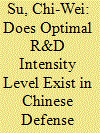

|
|
|
|
|
| Summary/Abstract |
This paper investigates whether there exists an optimal level of research and development (R&D) intensity, at which defense enterprises are able to maximize their market performance. The Panel Threshold Regression Model was applied to probe the link between R&D intensity and sales growth for defense listed enterprises, in China. The empirical results indicate that the Law of Gibrat does not hold and, unlimited input in R&D, does not guarantee positive paybacks. This may lead to the assumption that there is an optimal R&D intensity level in Chinese defense enterprises. Due to the fact that the defense industry has broken entrance barriers and considering the introduction of social capital into R&D activities, managers and top management should set more specific guidelines and provisional benchmarks to ensure effective R&D resource allocation in order to achieve maximum performance.
|
|
|
|
|
|
|
|
|
|
|
|
|
|
|
|
| 6 |
ID:
166574
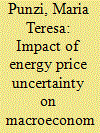

|
|
|
|
|
| Summary/Abstract |
This paper evaluates the macroeconomic implications of energy price volatility through the lens of a dynamic stochastic general equilibrium (DSGE) model in an open economy. The model develops a small open economy in which households consume energy products and firms use energy as productivity inputs, where the country is so small that it needs to import energy, the price of which is determined abroad. Whereas positive energy price shocks cause an economic slowdown due to higher costs for consumers and firms, energy price volatility shocks generate an increase in GDP in the short-run and a reversal in the long-run. These findings are empirically supported by estimates from a Panel VAR model applied to 10 Asian economies, where energy price volatility has a positive impact on GDP in the short-run. Moreover, the paper finds that increasing demand or supply uncertainty also affect energy prices, with amplified fluctuations relative to a model that abstracts from energy. Market volatility leads households to cut consumption for precautionary savings motives, which in turn increases investment.
|
|
|
|
|
|
|
|
|
|
|
|
|
|
|
|
| 7 |
ID:
172144


|
|
|
|
|
| Summary/Abstract |
This paper contributes to the analysis of the impact of military spending and corruption on economic growth, by considering not only the political dimension of corruption, distorting the allocation of resources to sectors, but also the impact on the efficiency of the bureaucratic environment. It does this by developing the model of Mauro (2004) in the context of an endogenous growth model to deal with corruption in the defence sector. It then uses data from the International Country Risk Guide to produce a novel measure of corruption that combines corruption within the political system, institutional strength, quality of bureaucracy and the degree of military participation in the country and estimates the model for a large panel of countries. The results suggest that both military spending (as a share of total government spending) and corruption have significant negative long run effects on output. As the model also suggests that multiple equilibria can exist, a comparison is made between high and low corruption groups of countries and clear differences are indeed found. This suggests that effort is needed to encourage and coerce high corruption and military spending countries, but low corruption and military spending countries are likely to need little attention.
|
|
|
|
|
|
|
|
|
|
|
|
|
|
|
|
| 8 |
ID:
164423
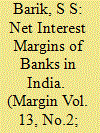

|
|
|
|
|
| Summary/Abstract |
Net interest margin (NIM) is the raison d’être of banking. It is an important measure of efficacy of the banking sector. At the system level, it is indicative of the cost of financial intermediation, health of the banking sector and its pricing power. In recent years, the Indian banking sector has experienced a major metamorphosis, with increasing competition and changing norms of liquidity, income recognition and capital. The end of regulatory forbearance and asset quality review (AQR) unearthed significant non-performing assets. This article traces the influence of various factors on the NIM, using bank-level data for 42 Indian banks over 25 quarters from March 2011 to March 2017. The study employs a dynamic panel generalised method of moments (GMM) framework to trace the impact of three distinct set of factors in setting banks’ NIMs: bank-level factors (like the share of low interest-bearing deposits held, the extent of gross non-performing assets [GNPAs], the capital-to-risk weighted assets ratio [CRAR], size of the loan book, operating costs and lending rates); system-level factors such as the monetary policy rate, credit growth and yields on government securities and macro-variables such as GDP growth and inflation. The results indicate that the main determinants of NIMs are banks’ CRAR levels, the proportion of current account and savings account deposits (CASA) to total deposits, operating costs and size of the loan book. Macro-factors like the growth of the economy and repo rate have a positive influence on the NIM.
|
|
|
|
|
|
|
|
|
|
|
|
|
|
|
|
| 9 |
ID:
134181
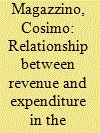

|
|
|
|
|
| Publication |
2014.
|
| Summary/Abstract |
The aim of this study is to assess the relationship between revenue and expenditure in the ASEAN countries. Using annual data for the period between 1980 and 2012 in ten member states, a long-run relationship between government expenditure and revenue emerges, both in ASEAN-6 and ASEAN-10 countries. Granger causality analysis shows mixed results, even though for five ASEAN countries the predominance of "tax-and-spend" hypothesis exists, given that government revenue drives the expenditure. Moreover, mixture models seem to produce homogeneous groups, considering the socio-economic structure, welfare state, and historical aspects. Finally, convergence measures show interesting results, confirming the sample's heterogeneity.
|
|
|
|
|
|
|
|
|
|
|
|
|
|
|
|
|
|
|
|
|